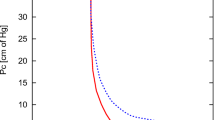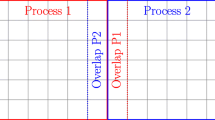Abstract
A new numerical model for the resolution of density coupled flow and transport in porous media is presented. The model is based on the mixed hybrid finite elements (MHFE) and discontinuous finite elements (DFE) methods. MHFE is used to solve the flow equation and the dispersive part of the transport equation. This method is more accurate in the calculation of velocities and ensures continuity of fluxes from one element to the adjacent one. DFE is used to solve the convective part of the transport equation. Combined with a slope limiting procedure, it avoids numerical instabilities and creates a very limited numerical dispersion, even for high grid Peclet number.
Flow and transport equations are coupled by a standard iterative scheme. Residual based criterion is used to stop the iterations. Simulations of an unstable equilibrium show the effects of the criteria used to stop the iterations and the stopping criterion in the solver. The effects are more important for finer grids than for coarser grids.
The numerical model is verified by the simulation of standard benchmarks: the Henry and the Elder test cases. A good agreement is found between the revised semi‐analytical Henry solution and the numerical solution. The Elder test case was also studied. The simulations were similar to those presented in previous works but with significantly less unknowns (i.e. coarser grids). These results show the efficiency of the used numerical schemes.
Similar content being viewed by others
References
Ackerer, P., Mosé, R. and Semra, K.: 1990, Natural tracer test simulation by stochastic particle tracking method, In: G. Moltyaner (ed.), Transport and Mass Exchange Processes in Sand and Gravel Aquifers, Ottawa, October 1–4 1990, pp. 595–604.
Ackerer, P., Mosé, R., Siegel, P. and Chavent, G.: 1996, Comment on ‘Application of the Mixed Hybrid Finite Element Approximation in a Groundwater Flow Model: Luxury or Necessity?’ by Cordes C., Kinzelbach W., Reply, Water Resour. Res. 32(6), 1991–1994.
Baranger, J., Maitre, J. F. and Oudin, F.: 1994, Application de la théorie des éléments finis mixtes á l'étude d'une classe de schémas aux volumes différences finis pour les problèmes elliptiques, C. R. Acad. Sci. Paris, t. 319, Série I, pp. 401–404.
Bear, J.: 1972, Dynamics of Fluids in Porous Media, Elsevier, New York.
Bear, J.: 1979, Hydraulic of Groundwater, McGraw-Hill Series in Water Resources and Environmental Engineering, McGraw-Hill, New York.
Chavent, G. and Jaffré, J.: 1986, Mathematical Models and Finite Elements for Reservoir Simulation, North-Holland, Amsterdam.
Chavent, G. and Roberts, J. E.: 1991, A unified physical presentation of mixed, mixed hybrid finite elements and standard finite difference approximations for the determination of velocities in water flow problems, Adv. Water Resour. 14(6), 329–348.
Ciarlet, P. G.: 1988, Introduction á l'Analyse Numérique Matricielle et á l'Optimisation, Masson Editeur.
Cordes, C. and Kinzelbach, W.: 1996, Comment on ‘Application of the Mixed Hybrid Finite Element Approximation in a Groundwater FlowModel: Luxury or Necessity?’, Water Resour. Res. 32(6), 1989–1990.
Cordes, C. and Putti, M.: 1996, Triangular mixed finite elements versus finite differences and finite volumes in groundwater flow modeling, In: A. Aldama, J. Aparicio, C. Brebbia, W. Gray, I. Herrera and G. Pinder (eds), Computational Methods in Water Resources, Comp. Mechanics Pub. pp. 61–68.
Dawson, C. N. and Wheeler, M. F.: 1992, Time splitting methods for advection-diffusion-reaction equations arising in contaminant transport, In: O'Malley (ed.), Industrial and Applied Mathematics, SIAM, pp. 71–82.
Elder, J. W.: 1966, Numerical experiments with a free convection in a vertical slot, J. Fluid Mech. 24, 823–843.
Elder, J. W.: 1967, Transient convection in a porous medium, J. Fluid Mech. 27, 609–623.
Hassanizadeh, M. S.: 1986, Derivation of basic equations of mass transport in porous media: 2. Generalized Darcy's and Fick's laws, Adv. Water Resour. 9, 207–222.
Hassanizadeh, M. S. and Leijnse, A.: 1988, On the modeling of brine transport in porous media, Water Resour. Res. 24(6), 321–330.
Henry, H. R.: 1964, Interfaces between salt water and fresh water in coastal aquifers, U.S. Geological Survey Water-Supply Paper 1613-C, Sea Water in Coastal Aquifers: C35–C70.
Herbert, A. W., Jackson, C. P. and Lever, D. A.: 1988, Coupled groundwater flowand solute transport with fluid density strongly dependent on concentration, Water Resour. Res. 24(10), 1781–1795.
Jaffré, J.: 1984, Décentrage et éléments finis mixtes pour les équations de diffusion-convection, Calcolo 21, 171–197.
Kaaschieter, E. F.: 1990, Mixed hybrid finite elements for saturated groundwater flow, In: Computer Method in Water Resources, Venice, Italy, June 11–15, Computational Mechanics Publications, pp. 17–22.
Kolditz, O., Ratke, R., Diersch, H. J. and Zielke W.: 1997, Coupled groundwater flow and transport: 1. Verification of variable density flow and transport models, Adv. Water Res. 21(1), 27–46.
Lever, D. A. and Jackson, C. P.: 1985, On the equation for the flow of concentrated salt solution through a porous medium, U.S. Department of Energy, Report No. DOE/RW/85. 100.
Mosé, R.: 1990, Application de la méthode des éléments finis mixtes hybrides et de la "marche au hasard" pour la modélisation de l'écoulement et du transport de masse en milieu poreux, PhD Thesis, Université Louis Pasteur, Strasbourg, France.
Mosé, R., Siegel, P., Ackerer, P. and Chavent, G.: 1994, Application of the Mixed Hybrid Finite Element Approximation in a Groundwater Flow Model: Luxury or Necessity? Water Resour. Res. 30(11), 3001–3012.
Oldenburg, C. M. and Pruess, K.: 1995, Dispersive transport dynamics in a strongly coupled groundwater-brine flow system, Water Resour. Res. 31, 289–302.
Peyret, R. and Taylor, T. D.: 1983, Computational Methods for Fluid Flow, Springer-Verlag, New York.
Raviart, P. A. and Thomas, J. M.: 1977, Amixed finite method for the second order elliptic problems, In: I. Galligani and E. Magenes (eds), Mathematical Aspects of the Finite Element Method, Lecture Notes in Mathematics, Springer-Verlag, Berlin, pp. 292–315.
Roberts, J. E. and Thomas, J. M.: 1991, Mixed and Hybrid Methods, In: P. G. Ciarlet and J. L. Lions (ed.), Handbook of Numerical Analysis, vol. 2, North-Holland, Amsterdam, pp. 523–639.
Roe, P. L.: 1986, Characteristic-based schemes for the Euler equation, Annu. Rev. Fluid Mech. 18, 337–365.
Segol, G.: 1994, Classic Groundwater Simulations: Proving and Improving Numerical Codes, Prentice-Hall, Englewood Cliffs, NJ.
Siegel, P., Mosé, R., Ackerer, Ph. and Jaffré J.: 1997, Solution of the advection dispersion equation using a combination of discontinuous and mixed finite elements, Int. J. Numer. Methods Fluids 24, 595–613.
Siegel, P., Mosé, R., Ackerer, Ph., Blaschke, A. and Jaffré, J.: 1995, Operator and time splitting to solve the diffusion convection equation, In: IX International Conference on Finite Elements in Fluids: News Trends and Applications, Venice 15–21/10/95, pp. 1617–1626.
Toro, E. F.: 1997, Riemann Solvers and Numerical Methods for Fluid Dynamics: A Practical Introduction, Springer-Verlag.
Van Leer, B.: 1977, Towards the ultimate conservative scheme: IV. A new approach to numerical convection, J. Comp. Phys. 23, 276–299.
Voss, C. and Souza, W. R.: 1987, Variable density flow and solute transport simulation of regional aquifers containing a narrow freshwater-saltwater transition zone, Water Resour. Res. 23(10), 1851–66.
Weiser, A. and Wheeler, M. F.: 1988, On convergence of block-centered finite differences for elliptic problems, SIAM J. Numer. Anal. 25, 351–375.
Wei, Y.: 1994, Stabilized finite element methods for miscible displacement in porous media, Math. Modelling Numer. Anal. 28(5), 611–665.
Younès, A., Ackerer, Ph. and Mosé, R.: Modeling variable density flow and solute transport in porous medium: 2. Re-evaluation of the salt dome flow problem (this issue).
Author information
Authors and Affiliations
Rights and permissions
About this article
Cite this article
Ackerer, P., Younes, A. & Mose, R. Modeling Variable Density Flow and Solute Transport in Porous Medium: 1. Numerical Model and Verification. Transport in Porous Media 35, 345–373 (1999). https://doi.org/10.1023/A:1006564309167
Issue Date:
DOI: https://doi.org/10.1023/A:1006564309167




